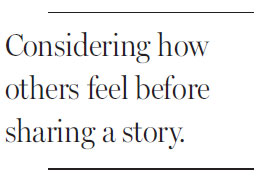Happiest news most forwarded
Updated: 2013-03-31 08:20
By John Tierney(The New York Times)
|
|||||||


Bad news sells.
That's a classic rule for the evening broadcasts and the morning newspapers, based partly on data and partly on the instincts of producers and editors. Wars, earthquakes, murdered spouses - the more suffering and mayhem, the more coverage.
But now that information is being spread in different ways, researchers are discovering new rules. By scanning people's brains and tracking their e-mails and online posts, neuroscientists and psychologists have found that good news can spread faster and farther than sad stories.
Jonah Berger, a social psychologist at the University of Pennsylvania, said mass media choose to cover traumatic events because bad news gets attention. Those outlets, too, "don't care how you're feeling," he said. "But when you share a story with your friends and peers, you care a lot more how they react."
Researchers analyzing word-of-mouth communication - e-mails, Web posts and reviews, face-to-face conversations - found that it tended to be more positive than negative.
Dr. Berger looked at how people spread a particular set of news stories: thousands of articles on The New York Times's Web site. He and Katherine Milkman, a Penn colleague, analyzed the "most e-mailed" list for six months.
One of his first findings was that articles and columns in the Science section were much more likely to make the list. Those stories aroused feelings of awe and made Times readers want to share this positive emotion with others.
Readers also tended to share articles that were exciting or funny, or that inspired negative emotions like anger or anxiety, but not articles that left them merely sad. They needed to be aroused one way or the other, and they preferred good news to bad. The more positive an article, the more likely it was to be shared, as Dr. Berger explains in his new book, "Contagious: Why Things Catch On."
"Stories about newcomers falling in love with New York City," he writes, were more likely to be e-mailed than "pieces that detailed things like the death of a popular zookeeper."
In another attempt to understand what news gets attention, neuroscientists have scanned the brains of people while they hear about new ideas. Then, as these people told others about what they had heard, the scientists observed which ideas spread and which didn't.
You might predict that people would pass along the most memorable ideas - the ones that lighted up the brain regions associated with encoding and retrieving memories. But in the experiments, which were conducted by other researchers, activity in brain regions associated with social cognition - thoughts about other people - indicated that people were more likely to talk about the idea.
"You'd expect people to be most enthusiastic and opinionated and successful in spreading ideas that they themselves are excited about," said Emily Falk, one of the researchers. But, she said, "thinking about what appeals to others may be even more important."
The New York Times
(China Daily 03/31/2013 page11)